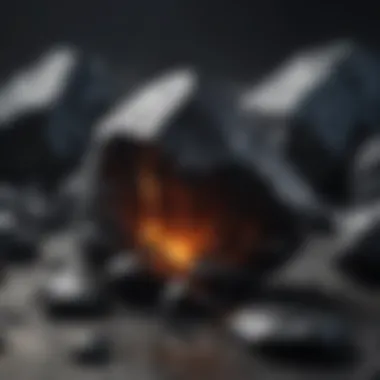Unraveling the Mysterious Charm of Obsidian Rock: Origins, Properties, and Cultural Significance


Rock and Fossil Identification
Obsidian rock, a mesmerizing natural glass of volcanic origin, embodies a mystique that intrigues enthusiasts and collectors worldwide. Born from the intense heat of volcanic activity, obsidian boasts a glossy, jet-black hue with occasional iridescent sheens. Its unique formation process results in a smooth, sharp-edged texture that sets it apart from traditional rocks. To identify obsidian, one should look for its distinct color, glass-like appearance, and conchoidal fractures, which create characteristic curved features when broken. Tools such as a hand lens can aid in closely examining the rock's surface and identifying its intricate patterns and structures.
Collecting Tips and Techniques
When venturing into collecting obsidian, it is essential to adhere to best practices to ensure a safe and fulfilling experience. Prime collecting sites are often nestled near active or historic volcanic regions, where obsidian can be found in abundance. To extract specimens safely, collectors should use tools like rock hammers and chisels to carefully dislodge pieces without causing damage. Proper safety gear, including gloves and eye protection, is crucial when handling sharp obsidian shards. Additionally, following land regulations and obtaining necessary permits are vital to preserve the landscape and maintain ethical collecting practices.
Preservation and Display
Preserving obsidian specimens involves delicate techniques to prevent damage and maintain their natural allure. Storing rocks in a dark, moisture-free environment helps prevent surface degradation and maintains their glossy finish. One creative display idea is to arrange multiple obsidian pieces on a backlit shelf to showcase their translucent properties under varying light conditions. By crafting custom stands or shadow boxes, collectors can elevate their display aesthetic and protect specimens from dust and handling.
Geological Insights
Exploring the geological significance of obsidian unveils a rich tapestry of volcanic formations and historical importance. Obsidian forms as lava rapidly cools, resulting in a unique glassy structure that captivates both geologists and collectors. Throughout history, obsidian held cultural value for various civilizations, often used in tools, jewelry, and spiritual practices. Notable archaeological discoveries, such as obsidian blades found in ancient sites, shed light on the material's enduring legacy and its diverse applications across different eras.
Introduction to Obsidian Rock
Defining Obsidian
Attempting to define obsidian proves to be a complex undertaking due to its unique composition and formation. Essentially, obsidian is a volcanic glass formed when molten lava cools rapidly without crystal growth, resulting in a smooth, reflective material. Its glassy texture and sharp edges set it apart from other rocks, making it a prized gem in the world of geology.
Origins of Obsidian
The origins of obsidian trace back to volcanic activity, where the rapid cooling of lava leads to the creation of this natural glass. Found near areas of past or present volcanic eruptions, obsidian is often associated with regions rich in volcanic history such as the Pacific Ring of Fire. Understanding its geological origins provides insights into its unique properties and allure as a material prized for both practical and aesthetic purposes.
Formation Process
The formation process of obsidian involves the rapid cooling of silica-rich lava, inhibiting crystallization and promoting glass formation. This rapid cooling results in a lack of crystal structure, giving obsidian its conchoidal fracture patterns and characteristic sharpness when fractured. By comprehending the intricate process of obsidian formation, we gain a deeper appreciation for the natural forces that shape this remarkable material.
Properties of Obsidian
Obsidian is characterized by a myriad of unique properties that distinguish it as a captivating natural glass formed by volcanic processes. Understanding the properties of obsidian is vital in appreciating its allure and significance in various fields ranging from geology to art and spirituality. This section will delve into the intricate details of obsidian's physical characteristics, chemical composition, and optical features, shedding light on its compelling nature.
Physical Characteristics
The physical characteristics of obsidian contribute to its exceptional beauty and utility. With a glossy, vitreous luster, obsidian exhibits varied colors such as black, gray, brown, and sometimes hues of red or green due to the presence of impurities. Its smooth, conchoidal fractures result in sharp edges when fractured, making it a favored material for crafting sharp tools and intricate ornaments. Furthermore, obsidian's high density and lack of crystal structure enhance its durability, rendering it resistant to weathering and corrosion. These physical properties render obsidian a versatile material with practical and aesthetic applications across diverse cultures and industries.
Chemical Composition


The chemical composition of obsidian plays a crucial role in determining its properties and behavior. Primarily composed of silica dioxide (Si O2), obsidian lacks substantial crystalline structure due to rapid cooling from its molten state. This results in an amorphous solid with minimal water content, contributing to its glassy texture and high refractive index. In addition to silica, obsidian may contain trace elements such as iron, magnesium, and calcium, influencing its coloration and overall appearance. Understanding the chemical composition of obsidian is essential for identifying its origin, age, and geological context, enriching its value in archaeological and geological studies.
Optical Features
The optical features of obsidian underscore its unique visual appeal and symbolic significance. Due to its lack of crystalline structure, obsidian exhibits isotropic behavior, appearing transparent to translucent under light. Its smooth surfaces and sharp edges interact with light, creating mesmerizing lustrous effects and unique color patterns. The internal fractures and inclusions within obsidian refract light, producing striking sheen and iridescence known as
The Utilitarian and Sacred Uses of Obsidian
In this section, we delve into the multifaceted aspects of Obsidian's utilitarian and sacred uses, revealing its profound influence across various domains. Obsidian, with its inherent sharpness and durability, has a rich history of serving practical purposes dating back centuries. This volcanic glass was utilized by ancient civilizations for crafting cutting tools, weapons, and implements due to its exceptional strength and sharp edges. Moreover, the religious and spiritual significance of Obsidian transcends mere functionality, as it holds symbolic value in rituals, ceremonies, and cultural practices. The sacred heritage of Obsidian is seen in diverse traditions worldwide, where it symbolizes protection, purification, and insight on both physical and metaphysical levels.
Historical Applications
In antiquity, Obsidian was treasured for its utility in creating sharp tools used for cutting, hunting, and crafting. Civilizations such as the Aztecs and the ancient Greeks crafted ornate ceremonial objects and weapons from this valuable material, showcasing its importance in their daily lives and rituals. The sharp, precise edges of Obsidian artifacts highlight its role in early human societies, where its practicality was indispensable. This historical context demonstrates the enduring legacy of Obsidian in technological advancements and ancient cultural practices.
Modern Uses
In contemporary times, Obsidian continues to find applications in various fields, ranging from surgical tools and blades to scientific instruments and artisanal creations. The exceptional sharpness and precision of Obsidian blades make them ideal for delicate surgeries and cutting-edge scientific procedures, reflecting the enduring relevance of this ancient material in modern-day contexts. Furthermore, artists and jewellers harness the aesthetic allure of Obsidian to create exquisite pieces that merge tradition with contemporary design sensibilities, showcasing its timeless appeal in the art world.
Cultural Significance
Beyond its functional attributes, Obsidian carries deep cultural significance for numerous indigenous communities worldwide, symbolizing strength, protection, and spiritual clarity. In cultures like the Maori of New Zealand or the Apache tribe in North America, Obsidian holds sacred value in ceremonies, rites of passage, and healing practices. The reverence for Obsidian transcends mere materialism, embodying a profound connection to the earth and spiritual realms. Its cultural resonance underscores the intricate interplay between nature, human beliefs, and societal values, enriching our understanding of the enduring allure of this enigmatic volcanic glass.
Obsidian in Art and Jewelry
The significance of obsidian in the realms of art and jewelry cannot be overstated. This section explores the value that obsidian brings to artistic expressions and adornments, elucidating its distinct characteristics and allure. Understanding the intricate relationship between obsidian and creative endeavors allows one to appreciate the profound influence this volcanic glass exerts on human craftsmanship.
Artistic Expressions
Artistic expressions involving obsidian encompass a wide array of forms, ranging from sculptures to intricately crafted objet d'art. The dark, lustrous nature of obsidian lends a mysterious charm to artistic creations, captivating viewers with its enigmatic beauty. Artists harness the unique properties of obsidian, such as its sharp edges and smooth texture, to translate their visions into tangible art pieces that evoke awe and intrigue. By incorporating obsidian into their works, artists infuse a sense of mystique and sophistication, elevating their creations to a whole new level of artistic merit.
Jewelry Making
In the realm of jewelry making, obsidian holds a coveted place for its timeless elegance and symbolic significance. Craftsmen and artisans craft exquisite pieces of jewelry using obsidian as the central element, exploiting its natural brilliance and depth to create stunning ornaments. The rich, velvety hues of obsidian pair harmoniously with various metals and gemstones, offering endless design possibilities for crafting unique and alluring jewelry pieces. Beyond its ornamental value, obsidian jewelry is often imbued with deep symbolic meanings in different cultures, serving as talismans for protection, clarity, and spiritual insight.
Symbolism and Meanings
Symbolism surrounding obsidian in art and jewelry transcends mere aesthetics, delving into realms of cultural heritage and personal beliefs. Across civilizations, obsidian has symbolized protection, strength, and grounding, embodying the primordial forces of nature in its sleek, dark form. In jewelry, obsidian is often associated with clarity of mind, emotional balance, and warding off negative energies, making it a sought-after gemstone for individuals seeking inner peace and spiritual alignment. The intricate patterns and reflections found within obsidian gems further enhance its symbolic potency, resonating with wearers on a profound level beyond mere adornment.
Obsidian and Archaeology


Obsidian holds a pivotal role in archaeological studies due to its remarkable properties that enable precise dating techniques and provide crucial insights into ancient human activities. The utilization of obsidian in archaeology has significantly contributed to understanding past civilizations, trade networks, and technological advancements. By analyzing obsidian artifacts, archaeologists can determine its trace elements and source origins, linking materials to specific geological regions. This method, known as Obsidian Hydration Dating, relies on the absorption of water into the exposed surface of obsidian over time, allowing researchers to estimate the artifact's age based on the thickness of the hydration rim. Moreover, obsidian trade and exchange networks have been unraveled through archaeological excavations, revealing the vast distances over which this prized material was transported in antiquity. The study of obsidian artifacts has led to groundbreaking archaeological discoveries, shedding light on ancient trade routes, cultural exchanges, and social interactions, shaping our understanding of prehistoric societies.
Obsidian Hydration Dating
Obsidian Hydration Dating is a technique used by archaeologists to determine the age of obsidian artifacts based on the rate of water absorption. When obsidian is exposed to air, it starts to accumulate a hydration layer on its surface. By measuring the thickness of this layer under a microscope, scientists can estimate the artifact's age. This dating method has revolutionized archaeological chronology, providing accurate timelines for various cultural periods and allowing researchers to establish chronological sequences of human activities within a specific region.
Trade and Exchange Networks
Obsidian served as a vital commodity in ancient trade and exchange networks, facilitating cultural interactions and economic relationships across distant regions. The procurement and distribution of obsidian reflect the complex trade networks that existed in antiquity, highlighting the extensive connections between different communities. Archaeological evidence of obsidian artifacts found far from its natural sources indicates long-distance trade routes and the value placed on this volcanic glass by ancient societies. The study of trade and exchange networks provides valuable insights into social structures, economic systems, and technological innovation in the past.
Archaeological Discoveries
Archaeologists have unearthed a multitude of significant discoveries through the analysis of obsidian artifacts, offering a glimpse into the material culture of ancient civilizations. Excavations at archaeological sites have revealed tools, weapons, and ceremonial objects made from obsidian, providing clues about craftsmanship, trade practices, and socio-cultural beliefs of bygone eras. The investigation of obsidian artifacts has led to the identification of trading hubs, consumption patterns, and cultural interactions on a regional and interregional scale, expanding our knowledge of human history and societal development.
The Mystique of Obsidian
Obsidian, with its enigmatic aura, holds a significant place in the realm of geological wonders. Its mystique goes beyond being a mere volcanic glass; it embodies a history shrouded in fascinating folklore, myths, and spiritual beliefs that have mesmerized civilizations for centuries. In this article, delving into 'The Mystique of Obsidian,' we unravel the enthralling tales and beliefs surrounding this enigmatic rock, shedding light on its profound impact on cultures worldwide.
Folklore and Myths
Obsidian's folklore and myths are as diverse as the regions where it is found. From ancient civilizations believing it to possess protective powers against negative energies to the intriguing legends of its origins as tears of the gods, obsidian brims with narratives that transcend time and borders. These stories not only add layers to obsidian's mystique but also highlight the deep-rooted connection between humanity and this captivating volcanic glass.
Healing and Metaphysical Properties
Exploring the realm of healing and metaphysical properties attributed to obsidian unveils a fascinating perspective on this natural gem. Believed to shield from psychic attacks, absorb negative energies, and promote emotional balance, obsidian is revered for its protective and grounding abilities. Its smooth texture and dark hue create a sense of stability and tranquility, making it a sought-after tool in alternative healing practices and energy work.
Spiritual Significance
The spiritual significance of obsidian transcends its physical properties, delving into the realm of the unseen and the metaphysical. Revered as a stone of truth, protection, and transformation, obsidian is often used in spiritual rituals, meditations, and ceremonial practices to enhance spiritual awareness and foster inner growth. Its reflective surface symbolizes introspection and self-discovery, guiding individuals on a journey of self-realization and inner healing. The spiritual depth of obsidian adds a layer of reverence to its enigmatic allure, making it a captivating subject of contemplation and exploration.
Collecting and Preserving Obsidian Specimens
In this section, we delve into the crucial aspects of collecting and preserving obsidian specimens, shedding light on the meticulous practices essential for rock and fossil collectors. Understanding the significance of preserving these specimens is paramount in maintaining their integrity and value. Collecting obsidian goes beyond a mere hobby; it is a meticulous process that requires care and attention to detail. Collectors need to be well-versed in the geological composition of obsidian to identify valuable specimens worth preserving. Preserving obsidian specimens ensures their longevity and prevents degradation over time, safeguarding their natural beauty and historical importance. By learning how to properly collect and preserve obsidian, collectors contribute to the conservation and appreciation of these unique geological treasures.
Best Practices for Collectors
For collectors passionate about obsidian, adhering to best practices is imperative to ensure the quality and authenticity of their specimens. Firstly, collectors should conduct thorough research on the types and origin of obsidian they aim to collect. Understanding the geological background of various obsidian types aids collectors in identifying genuine specimens and differentiating them from common glass imitations. Additionally, practicing ethical collection methods is vital to preserve the natural environment and minimize disturbances to geological sites. Collectors should obtain necessary permits and seek permission before collecting obsidian to promote responsible and sustainable collection practices. By adopting best practices, collectors uphold the integrity of their collections and contribute to the preservation of natural landscapes.
Preservation Techniques


Preserving obsidian specimens requires employing effective techniques to prevent damage and maintain their inherent characteristics. Storing obsidian in a controlled environment away from direct sunlight and extreme temperatures helps prevent discoloration and structural deterioration. Utilizing acid-free padding or containers ensures that specimens remain free from chemical reactions that may impact their composition. Implementing proper cleaning and handling methods, such as using soft brushes and non-abrasive tools, prevents scratches and surface damage. Preservation techniques also include documentation processes like labeling specimens with relevant information, facilitating easy tracking and identification within collections. By mastering preservation techniques, collectors safeguard the integrity and longevity of their obsidian specimens for future generations to appreciate.
Display and Storage Tips
Displaying and storing obsidian specimens require careful consideration to showcase their beauty and significance effectively. When designing display spaces, collectors should prioritize minimal direct exposure to light to prevent fading and discoloration of specimens. Utilizing specialized display cases with UV-protection features helps maintain the visual appeal of obsidian while shielding them from environmental factors. Choosing display methods that allow for adequate airflow reduces the risk of moisture accumulation, preserving the pristine condition of the specimens. Proper labeling with detailed information enhances the educational value of the display and enriches the viewer's understanding of each specimen's unique properties. Employing aesthetically pleasing storage solutions ensures that obsidian collections are both organized and visually appealing, captivating enthusiasts and researchers alike.
Obsidian Mining and Extraction
Obsidian mining and extraction play a pivotal role in unraveling the mysteries of this unique volcanic glass. Approaching the concept of mining obsidian necessitates a profound understanding of its geological significance and cultural value. Mining operations are carefully executed in specific regions worldwide where obsidian deposits are plentiful, ensuring the preservation of these natural resources for future generations. The extraction process involves intricate techniques that require precision and expertise to unearth obsidian specimens without compromising their integrity. The meticulous excavation methods employed in obsidian mining ensure that each piece extracted retains its pristine quality, ready to be utilized for various purposes.
Global Sources of Obsidian
Exploring the global sources of obsidian unveils a captivating narrative of how this extraordinary material is distributed across different geological regions. From the volcanic landscapes of Iceland to the rich obsidian deposits in Mexico, each source offers a distinctive variety of obsidian with unique physical and chemical properties. Understanding the geographical diversity of obsidian sources provides valuable insights into the varying characteristics of this volcanic glass, influencing its applications in art, jewelry, and scientific research. Geological surveys and studies continue to reveal new sources of obsidian, expanding the knowledge base and enriching the availability of this enigmatic material for enthusiasts worldwide.
Mining Techniques
The techniques employed in obsidian mining reflect a harmonious blend of traditional practices and modern advancements. Skilled miners utilize specialized tools to extract obsidian from volcanic sites, incorporating age-old methods passed down through generations with innovative technologies to enhance efficiency and safety. The delicate nature of obsidian requires careful handling during the mining process to prevent fractures or damage to the specimens. Miners navigate through challenging terrains, employing precise techniques to collect prime specimens of obsidian that exhibit exquisite clarity and color varieties, showcasing the sheer beauty and diversity of this remarkable volcanic glass.
Economic Importance
The economic importance of obsidian mining extends beyond its intrinsic value as a geological marvel to its contributions to various industries. The extraction and trade of obsidian not only stimulate local economies in mining regions but also fuel the creation of artisanal products, jewelry items, and archaeological replicas. The economic significance of obsidian manifests in its role as a commodity for collectors and researchers, driving demand for high-quality specimens sourced from reputable mines. Additionally, the commercial aspect of obsidian mining sustains livelihoods for communities dependent on the extraction and processing of this alluring volcanic glass, emphasizing its enduring appeal and practical applications in diverse fields.
Future Prospects of Obsidian
Obsidian, with its rich history and unique properties, presents a realm of promising future prospects. Within the context of this comprehensive exploration into the allure of obsidian rock, understanding its potential trajectory becomes paramount. The future prospects of obsidian encapsulate a blend of tradition, innovation, and sustainability, shaping its significance in various domains.
Research and Innovations
Delving into research and innovations surrounding obsidian unveils a horizon of possibilities. Scholars and enthusiasts alike are immersing themselves in studies to unlock the hidden depths of obsidian's properties and applications. Whether through advanced geological analyses or cutting-edge technologies, ongoing research is shedding new light on this enigmatic rock, propelling it towards unforeseen horizons of exploration and discovery.
Environmental Concerns
As we delve deeper into the potential of obsidian, environmental considerations come to the forefront. The extraction and manufacturing processes associated with obsidian raise vital concerns regarding ecological impact and sustainability. Addressing these environmental challenges becomes integral to ensuring a balanced approach towards harnessing the potential of obsidian while preserving the delicate equilibrium of natural ecosystems.
Potential Applications
The spectrum of potential applications for obsidian is vast and diverse, mirroring its multi-faceted nature. From innovative construction materials to cutting-edge technologies, obsidian's unique properties offer a palette of possibilities. Exploring the horizons of its applications, one can envision a future where obsidian plays a pivotal role in fields ranging from medicine to art, opening up avenues for creativity and advancement.
Conclusion
Obsidian rock, with its enigmatic allure and historical significance, stands as a unique geological marvel. Throughout this article, we have explored the various facets of obsidian - from its physical properties to its cultural and spiritual significance. Understanding the enduring allure of obsidian provides insight into the deep-rooted connection between humans and natural materials. As collectors and enthusiasts delve into the world of obsidian, they uncover not just a volcanic glass but a journey through time and space, unravelling the mysteries woven within its gleaming surfaces. The allure of obsidian extends beyond its aesthetic appeal, offering a gateway to ancient traditions, modern applications, and scientific innovations that continue to shape our perception of this mesmerizing rock.
The Enduring Allure of Obsidian
Obsidian, cloaked in enigma and shaped by volcanic forces, holds an undeniable allure that transcends its geological origins. Its rich history intertwines with human civilization, embodying strength, mystery, and cultural heritage in its lustrous depths. The striking contrast between obsidian's dark hues and its translucent sheen evokes a sense of wonder and reverence, drawing collectors and artisans into its mesmerizing embrace. Through the ages, obsidian has served as more than just a material but a symbol of resilience, transformation, and spiritual insight. Its enduring allure lies not only in its physical beauty but also in the stories it carries within its sleek contours, inviting us to explore the depths of our past and the potentials of our future.







